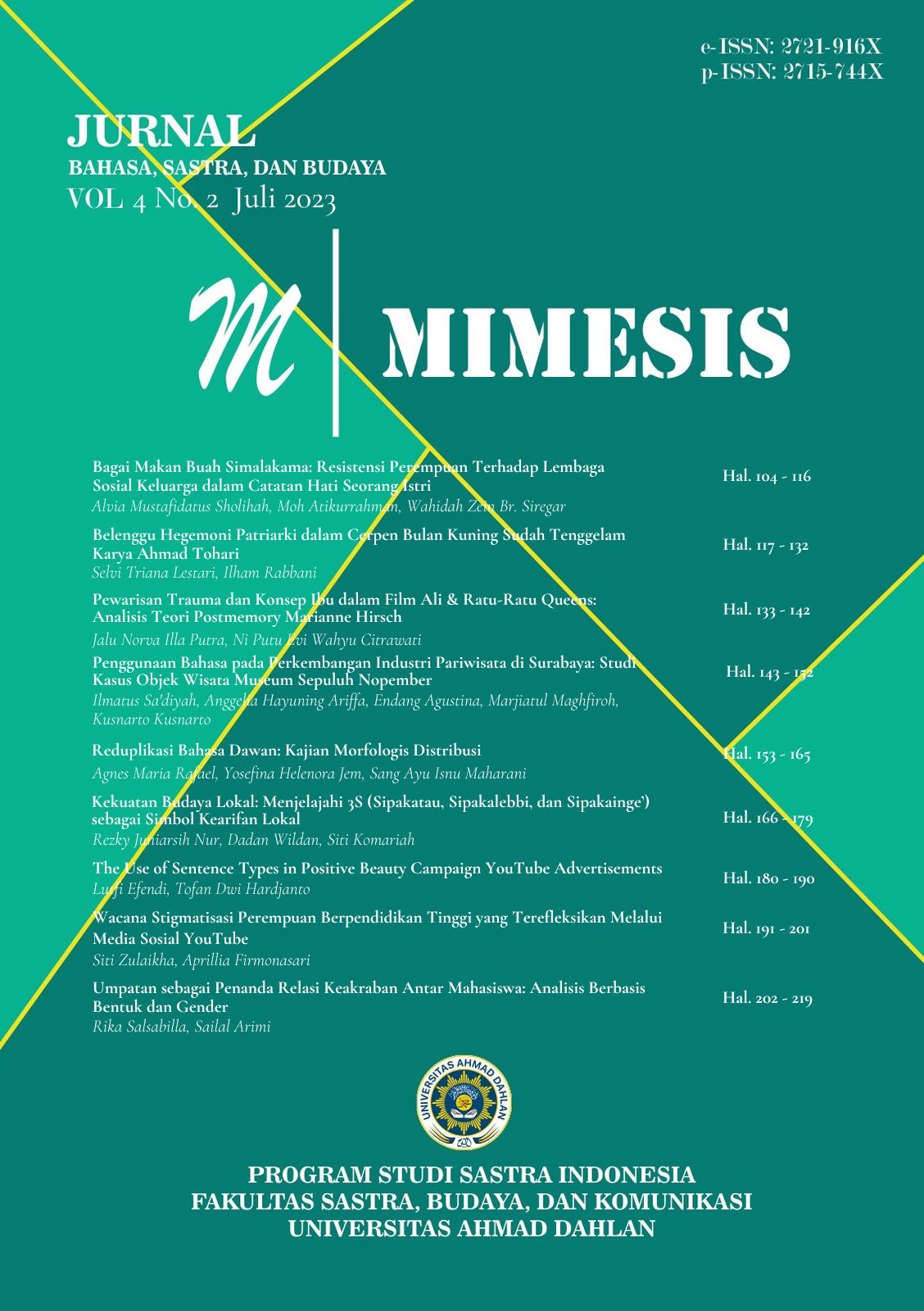Reduplikasi Bahasa Dawan: Kajian Morfologis Distribusi
DOI:
https://doi.org/10.12928/mms.v4i2.8083Keywords:
Dawan Language, Distribution Morphology, Morphology, ReduplicationAbstract
This article is intended to investigate the reduplication processes of bahasa Dawan spoken by Dawan people in NTT Province by using the morphological distribution theory proposed by Framton in 2004. To complete the study, a qualitative research method had been chosen based on the consideration that the data were in the form of words. Those data were taken from the utterances spoken in Dawan’s traditional ceremony as the main data source. Besides, Tata Bahasa Dawan book played a role as the secondary data source. The data were collected by observation and studying the document. In observation, the researchers observed and recorded the utterances by using an android, however the document study was done by reading documents about Bahasa Dawan. The study result reveals that in bahasa Dawab there are three processes in reduplication, namely 1) full reduplication without affixation process, 2) full reduplication with affixation process, and 3) partial reduplication.
References
Benu, Naniana Nimrod (2014). Konstruksi Verba Serial Bahasa Dawan. Tesis Program Magister, Program Studi Linguistik Program Pascasarjana Universitas Udayana.
Camalia, M. (2016). Reduplikasi Bahasa Bugis, Kajian Morfologi Distribusi. LOA Journal.Vol 11, No.1.
Framton. (2009). Distributed Reduplication. MS. MIT.
Ghomeshi, J., Jackendoff, R., Rosen, N. & Russell, K. (2004). Contrastive Focus Reduplication in English (The Salad-Salad Paper). Natural Language & Linguistic Theory 22, 307–357. https://doi.org/10.1023/B:NALA.0000015789.98638.f9
Halle, M., & Marantz, A. (1993). “Distributed Morphology and the Pieces of Inflection,”in K. Halle & S. Keyser (eds.) The View from Building 20. Cambridge, MA: MIT Press.
Kridalaksana, H. (2007). Pembentukan Kata Dalam Bahasa Indonesia. Jakarta. Gramedia.
Lieber, Rochelle. (2009). Introducing Morphology. New York: Cambridge University Press.
Ong, S. N. dan Hamzah, Z. A. Z. (2020). Bentuk, Fungsi, dan Distribusi Reduplikasi Kata Benda Bahasa Melayu dan Bahasa Jepang. JOURNAL OF JAPANESE LANGUAGE EDUCATION & LINGUISTICS. Vol. 4, No. 1.
Ramlan. (2001). Morfologi Suatu Tinjauan Deskriptif. Yogyakarta. CV. Karyono.
Tarno, dkk. (1992). Tata Bahasa Dawan. Jakarta: Pusat Pembinaan, dan Pengembangan Bahasa Departemen Pendidikan dan Kebudayaan.
Tenis, Horiana Ilyadim Yoseph B. Kroon, dan Johnson W. Haan. (2018). Peran semantis Argumen Klausa Verbal Bahasa Dawan Dialek Amanuban. Sasdata: Gadjah Mada Journal of Humanities. Vol. 2, No.2.
Downloads
Published
Issue
Section
License
Copyright (c) 2023 Agnes Maria Rafael, Yosefina Helenora Jem, Sang Ayu Isnu Maharani

This work is licensed under a Creative Commons Attribution-ShareAlike 4.0 International License.
License and Copyright Agreement
In submitting the manuscript to the journal, the authors certify that:
- They are authorized by their co-authors to enter into these arrangements.
- The work described has not been formally published before, except in the form of an abstract or as part of a published lecture, review, thesis, or overlay journal.
- That it is not under consideration for publication elsewhere,
- That its publication has been approved by all the author(s) and by the responsible authorities tacitly or explicitly of the institutes where the work has been carried out.
- They secure the right to reproduce any material that has already been published or copyrighted elsewhere.
- They agree to the following license and copyright agreement.
Copyright
Authors who publish with Mimesis agree to the following terms:
- Authors retain copyright and grant the journal right of first publication with the work simultaneously licensed under a Creative Commons Attribution License (CC BY-SA 4.0) that allows others to share the work with an acknowledgment of the work's authorship and initial publication in this journal.
- Authors are able to enter into separate, additional contractual arrangements for the non-exclusive distribution of the journal's published version of the work (e.g., post it to an institutional repository or publish it in a book), with an acknowledgment of its initial publication in this journal.
- Authors are permitted and encouraged to post their work online (e.g., in institutional repositories or on their website) prior to and during the submission process, as it can lead to productive exchanges, as well as earlier and greater citation of published work.











